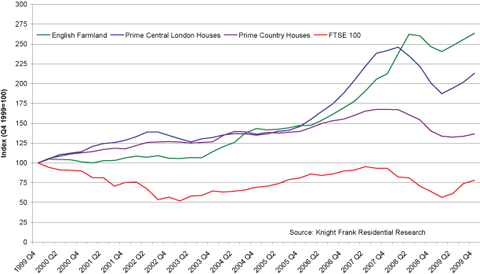Farmland prices increased by 164% during the last decade
English farmland market ends the decade with a flourish as values hit a new record high, says Knight Frank.
English farmland values rose by 3% in the fourth quarter of 2009 taking annual growth to 6.8%, according to the latest results of the Knight Frank Farmland Index.
Farmland prices increased by 164% during the last decade, compared with growth of 37% for prime country houses, 113% for prime residential property in Central London and a 22% drop in the value of the FTSE 100 share index
The amount of farmland publicly advertised for sale in 2009 fell by almost 30% and this shortage of supply is helping to push up values as demand remains buoyant
Farmland values are predicted to continue increasing this decade and could double in value again
Andrew Shirley, head of rural land research at Knight Frank, commented:
"It seems fitting that farmland, which has been one of the strongest performing assets in recent years, should end the decade at an all-time high. A 3% increase in the value of the Knight Frank Farmland Index during the final quarter of 2009 means farmland prices have risen by 164% in the last decade.
“Even prime London property, which saw especially rapid growth before the credit crunch, could only manage growth of 113%, according to our Prime Central London Index, and the FTSE 100 index actually fell in value during the same period. Of the major asset classes, only gold – the ultimate safe haven for investors in difficult times – has managed a stronger performance, with a 300% hike in its value over the decade.

Shortage of land drives market
“A shortage of land for sale was one of the key drivers of the market in the last decade and continues to underpin values now. Ten years ago 226,000 acres of farmland were sold in England alone, according to the then Ministry of Agriculture, Fisheries and Food. Last year, under 150,000 acres were advertised publicly across Britain, about 30% fewer than in 2008. A significant increase in sales during 2010 is not expected as the majority of owners hold land as a long-term investment and currently have little incentive to sell.
“This dwindling supply of land is being fought over by a large number of potential buyers that shows no sign of abating. Commercial UK farmers remain the largest source of buyers, although their 47% share of the market was down about 8% on the previous quarter, possibly because of lower commodity prices. “Lifestyle” purchasers looking for attractive residential farms were involved in a quarter of sales.
Farmland on investors’ radar
“There was a noticeable return of institutional and private investors, many of whom were forced out of the market due to lack of funds in the aftermath of the credit crunch. As the world population grows, eating habits change and more and more farmland is lost to development and degradation, the investment rationale behind farmland will remain strong. Even the UK’s Labour government, not traditionally perceived as having close links with agriculture, has now recognised that food security is an issue the UK has to face.
“The ongoing imbalance between supply and demand means prices will continue to increase and may well double before the end of the next decade. The uncertainty associated with a general election in the first half of 2009 could limit market activity, but we expect average values to climb by at least a further 5% next year.
“Large blocks of productive land will lead the way, but as credit conditions begin to ease, smaller blocks of amenity land will prove increasingly popular once more with lifestyle buyers. Less productive parcels of land with limited amenity value will not achieve such good prices unless there is interest from neighbouring farmers.”
Knight Frank, 15 Jan 2010
